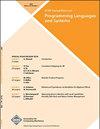有限列表的龟兔赛跑算法
IF 1.6
2区 计算机科学
Q3 COMPUTER SCIENCE, SOFTWARE ENGINEERING
引用次数: 0
摘要
在乌龟和兔子算法中,当快速指针到达有限列表的末尾时,慢速指针指向该列表的中间。在2000年代初,人们发现这种特性可以为不可变列表编程一个回文检测器,该检测器在给定列表的一次递归遍历中操作,并使用“There and Back Again”(TABA)递归模式执行尽可能少的比较。在本文中,这个回文检测器是在OCaml中重建的,并用Coq-Proof Assistant形式化,证明了它的正确性。更广泛地说,本文介绍了有限列表的乌龟和兔子算法的组成说明。具体来说,复合性意味着使用快速和慢速指针的程序可以用列表的普通折叠函数来表达,并对给定列表使用普通结构归纳进行推理。本文还包含TABA递归模式及其尾部递归变体“There and Forth Again”的十几个新应用程序。本文章由计算机程序翻译,如有差异,请以英文原文为准。
The Tortoise and the Hare Algorithm for Finite Lists, Compositionally
In the tortoise-and-hare algorithm, when the fast pointer reaches the end of a finite list, the slow pointer points to the middle of this list. In the early 2000’s, this property was found to make it possible to program a palindrome detector for immutable lists that operates in one recursive traversal of the given list and performs the smallest possible number of comparisons, using the “There And Back Again” (TABA) recursion pattern. In this article, this palindrome detector is reconstructed in OCaml, formalized with the Coq Proof Assistant, and proved to be correct. More broadly, this article presents a compositional account of the tortoise-and-hare algorithm for finite lists. Concretely, compositionality means that programs that use a fast and a slow pointer can be expressed with an ordinary fold function for lists and reasoned about using ordinary structural induction on the given list. This article also contains a dozen new applications of the TABA recursion pattern and of its tail-recursive variant, “There and Forth Again”.
求助全文
通过发布文献求助,成功后即可免费获取论文全文。
去求助
来源期刊

ACM Transactions on Programming Languages and Systems
工程技术-计算机:软件工程
CiteScore
3.10
自引率
7.70%
发文量
28
审稿时长
>12 weeks
期刊介绍:
ACM Transactions on Programming Languages and Systems (TOPLAS) is the premier journal for reporting recent research advances in the areas of programming languages, and systems to assist the task of programming. Papers can be either theoretical or experimental in style, but in either case, they must contain innovative and novel content that advances the state of the art of programming languages and systems. We also invite strictly experimental papers that compare existing approaches, as well as tutorial and survey papers. The scope of TOPLAS includes, but is not limited to, the following subjects:
language design for sequential and parallel programming
programming language implementation
programming language semantics
compilers and interpreters
runtime systems for program execution
storage allocation and garbage collection
languages and methods for writing program specifications
languages and methods for secure and reliable programs
testing and verification of programs
 求助内容:
求助内容: 应助结果提醒方式:
应助结果提醒方式:


